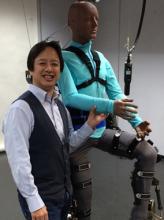A paralyzed person wearing a brain-controlled robotic exoskeleton is expected to make the first kick during the opening of the 2014 World Cup in Brazil. The technology was developed by the Walk Again Project, an international collaboration of more than one hundred scientists.
Eight Brazilian patients, men and women between ages 20 and 40 who are paralyzed from the waist down, have trained for months to use the exoskeleton. The system works by recording electrical activity in the patient’s brain, recognizing his or her intention (eg, to take a step or kick a ball), and translating the intention into action. The system gives the patient tactile feedback using sensitive artificial skin created by the Technische Universität München (TUM).
Animal Study Inspires Human Research
Inspiration for the Walk Again Project and for the artificial skin called CellulARSkin technology came from a collaboration in 2008 between Miguel Nicolelis, MD, PhD, Professor of Neurobiology, Biomedical Engineering, and Psychology and Neuroscience at Duke University in Durham, North Carolina, and Gordon Cheng, PhD, Head of the Institute for Cognitive Systems at TUM. “Miguel set up a monkey walking on a treadmill in North Carolina, and then I made my humanoid robot walk with the signal in Kyoto,” said Dr. Cheng. This experiment gave the researchers the idea of helping a paralyzed person to walk using a robotic exoskeleton that could be guided by mental activity alone.
The researchers understood that technical advances would be required to allow a relatively compact, lightweight exoskeleton to be assembled, and that visual feedback would not be enough. Dr. Cheng believed that a sense of touch would be essential for the patient’s emotional comfort, as well as for control over the exoskeleton. The researchers began looking for a way to give a paralyzed person the ability to walk and the feeling of touching the ground.
Technology May Improve Human–Machine Interactions
Dr. Cheng and his collaborators ultimately developed CellulARSkin, which provides a framework for a self-organizing surface sensor network. The technology can be implemented using standard off-the-shelf hardware and may benefit from future improvements in miniaturization, performance, and cost.
The basic unit is a flat, six-sided package of electronic components, including a low-power–consumption microprocessor, as well as sensors that detect pretouch proximity, pressure, vibration, temperature, and movement in three-dimensional space. Any number of these individual cells can be networked together in a honeycomb pattern that is protected in the current prototype by a rubbery skin of molded elastomer.
“It’s not just the sensor that’s important,” said Dr. Cheng. “The intelligence of the sensor is even more important.” Cooperation among the networked cells and between the network and a central system allows CellulARSkin to configure itself for each specific application and to recover automatically from certain kinds of damage. These capabilities may enable safe interactions between machines and people.
In the Walk Again Project, CellulARSkin is being used in two ways. The technology is integrated with the exoskeleton (eg, on the bottoms of the feet) and sends signals to tiny motors that vibrate against the patient’s arms. Through training with this indirect sensory feedback, a patient can learn to incorporate the robotic legs and feet into his or her own body schema. CellulARSkin is also being wrapped around parts of the patient’s body to help the medical team monitor for signs of distress or discomfort.


